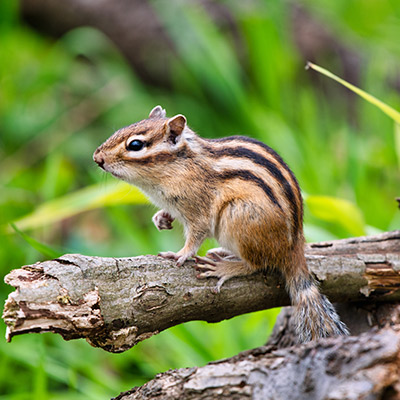Naturalist’s Notebook
by Don Lane
The 1,400+ acres of the Chicopee Woods Nature Preserve are, mostly, deciduous forest. Some areas comprised of a majority of pines do exist in the preserve, but these areas largely occur where soil, moisture and other conditions exist that do not promote the growth of deciduous trees.
In grade school we learned that deciduous trees are those trees that lose their leaves in fall, as opposed to evergreen trees that keep their leaves (or needles) year-round. Chicopee Woods is also located in the Appalachian Mountain range, albeit in the extreme southern extent of the Appalachians. The Appalachians are known for their abundance of deciduous or broadleaf species of trees.
A large portion of planet Earth has what is referred to as a “temperate” climate. A temperate climate is neither very hot or very cold, nor very wet or very dry. The climate of Georgia is largely deemed temperate. It is in this type of climate that deciduous forests thrive. Because of its nature of changing throughout the seasons of the year, the deciduous forest is a dynamic, active environment. In spring, the forest changes from brownish hues to mottled green, to bright, vibrant green in summer, to splendid reds, yellows, and oranges in fall, and back to brown again as the deciduous trees go dormant in winter.
Looking at a map of forests of the world, deciduous forests are found largely north of the equator. They lie below the drier, colder evergreen forests found in upper latitudes of the northern hemisphere. While deciduous forests can be found in the southern hemisphere-at the southern tip of South American and in New Zealand for example-deciduous forests are mostly associated with the northern hemisphere and particularly North America.

Many animals call the deciduous forests home. One such animal is a tiny rodent with a big appetite. While seemingly not as plentiful as squirrels in the Chicopee Woods, the Eastern chipmunk is an important member of the deciduous forest animal community. The range of chipmunks in Georgia coincides with the range of deciduous forest in the state. Important to the health of the forest ecosystem, the chipmunks are a food source for a number of predators including hawks, snakes, weasels, foxes, bobcats, raccoons, rats, owls, and coyotes. Because their diet largely consists of seeds and nuts, chipmunks are an important disperser for plants.
To be so small, chipmunks can make quite a racket foraging through dry leaves on the forest floor in search of food. I recall an occasion from my youth when I was sitting in the forest by myself and being very still and quiet. Not long after settling down and getting comfortable I heard noises coming from behind me that sounded like a small- to medium-sized tank coming through the woods. My young mind immediately went to thoughts of a bear, or even worse a malevolent bigfoot. I remained still. In a few minutes, out of the corner of my eye, the denizen of the deep, dark forest came into view. Not a bigfoot, not a bear, but a chipmunk. It continued poking its head under the leaves looking for food totally impervious to my presence until my leg started to cramp. I stretched, it saw me, emitted an alarm “squeak” and ran off as fast as it could. Relieved and a little chagrinned, I decided it was about time to head back to camp.
Chipmunks are hoarders. Not in the same sense as humans depicted on the A&E TV show, but rather they stuff their cheeks with the nuts and seeds found while foraging the forest floor and take them back to their underground burrow largely for use during the winter.
Even in the coldest climes, chipmunks don’t really hibernate in the same way a bear might. Bears generally sleep through the winter and get nutrition through stored body fat. Chipmunks retreat to their burrows, but only to sleep for a while. Every few days they awake, grab a snack from their cache of seeds and nuts, and go to the bathroom. Since they don’t hibernate in bear fashion, they don’t rely on stored body fat to get them through the winter as do bears.
There are areas within the deciduous forest that provide ever-changing habitats for a variety of plants and animals. One such place is where a tree has fallen-ether because of natural death or up-rooted by a storm. The felled tree creates a clearing in the forest. This clearing allows sunlight to reach the forest floor where, previously, little sunlight fell except in winter.
Plants and animals that enjoy being in the light colonize the clearing and will thrive until such time as the trees gain sufficient height to, once again, bring shade to the forest floor. The “wound” in the forest has healed itself. There are clearing that can be found in the forest that appear not to have been the result of a fallen tree. In the deciduous forest of the Chicopee Woods these clearings can be a result of mineral content of the soil, moisture, or the slope of the land not being conducive for the growth of deciduous trees.
Deciduous forests are a naturalists dream in that they contain a myriad of plants and animals to study and observe. Deciduous forests change with the seasons offering the naturalist the opportunity to see how a plant or a group of plants transform from spring to summer to fall to winter.
It is important to note that, while the Chicopee Woods is largely deciduous forest, there are many types of deciduous forests. I doubt that many people realize, while hiking the trails of the Chicopee Woods, they often cross from one type of deciduous forest into another type and sometimes, back again. Only knowledgeable naturalists (and some scientists) have the ability to discern where these forests begin and end along a trail. Next time: a hike through some of the different types of forests found in Chicopee Woods.
